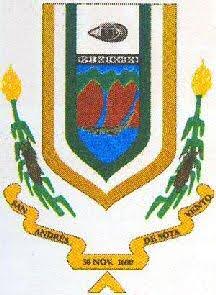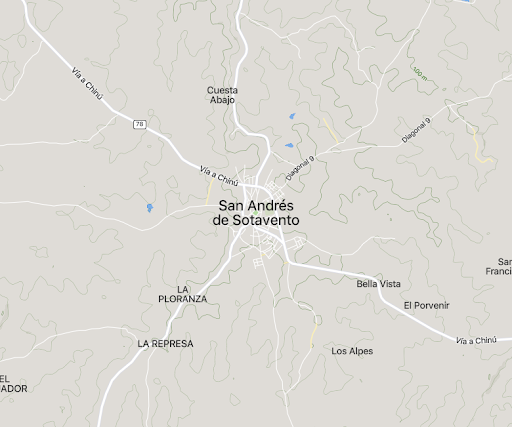SOTAVENTO
Department

Flag of the city
The flag of the city includes color yellow and green, with the Vueltiao hat located at the center of the flag. The Vueltiao hat, which is the son of the braid, represents the Zenú culture to the world.



San Andrés de Sotavento has a rich history dating back to the pre-colonial era when its territory was part of the chiefdom of Pinchorroy, a political-administrative unit within the Zenú culture. The Zenúes, a native group, lived in semi-nomadic conditions, and San Andrés de Sotavento’s territory likely hosted dispersed communities. Before the formal foundation of the town on November 30, 1600, the area had a settlement referred to as a “Pueblo De Indios.” This settlement, organized in a non-Spanish manner, indicates a pre-existing indigenous presence. The organization of the town didn’t align with typical Spanish parameters, suggesting its establishment might predate Spanish colonization. The formation of San Andrés de Sotavento as a hamlet could be linked to forced displacements that began in 1535. Zenú natives experienced violent displacement from other regions, notably from places like Betancí, a prosperous town impacted by the Spanish invasion. The displaced population, possibly ancestors of those settling in the municipality today, faced precarious conditions, transitioning from larger, wealthier towns to surviving in hilly landscapes. The town’s foundation in 1600 marked a new chapter in its history, influenced by the complex interactions between indigenous cultures and the impact of Spanish colonization. The historical roots of San Andrés de Sotavento are deeply intertwined with the Zenú culture, displacement, and the challenges faced by native populations during the colonial period.
Geography of the city
San Andrés de Sotavento is positioned in the torrid intertropical zone of low latitudes, located at approximately 9° 08′ and 57” north latitude and 57° 30′ and 44” west longitude in relation to the Greenwich Meridian. This astronomical placement places it in the Caribbean region, subject to specific climatic patterns. The town experiences a tropical dry forest climate (bs-T) according to the classification of the Municipality of San Andrés de Sotavento. The region has two distinct seasons: a period of rain and a period of drought. Instead of the typical four seasons, this area, situated in the torrid intertropical zone, follows a pattern of alternating wet and dry seasons. Elevations such as Cerro de Tofeme and Anguilla contribute to the topographical features of San Andrés de Sotavento. The entire territory is characterized as hot lands with varying rainfall and high temperatures. Microclimatic variations exist within the same life zone, with increased humidity toward the south due to seawater currents. The semi-dry climate is a hallmark of the department of Córdoba and the Caribbean region, influenced by dry winds from the northeast. These winds, upon reaching the continent, remove atmospheric humidity until encountering natural barriers where air masses are deposited. Municipal Boundaries are presented below
North: Department of Sucre, Municipality of Sincelejo, district of Buenavista.
Northeast: Department of Sucre, Municipality of Sincelejo, Corregimiento of Babilonia.
East: Department of Sucre, Municipality of Sampués, Corregimiento of Siloé and Chinú.
South: Ciénaga de Oro Córdoba and Chinú.
Northwest: Municipality of Tuchín Córdoba.
Southwest: Municipality of Chimá Córdoba.
These geographical features contribute to the environmental and climatic characteristics that shape life in San Andrés de Sotavento. The town’s location, topography, and climate play a crucial role in defining its natural environment and ecosystem.

Population
Total – 48,947 inhabitants (2015)
Urban – 16,541 inhabitants (2015)
One photo representative of the city

Etymology
“San Andrés” is a common name for places in the Spanish-speaking world, often derived from the name of Saint Andrew (San Andrés in Spanish), who is one of the twelve apostles of Jesus in Christian tradition. The use of “San Andrés” suggests a connection to Christian heritage, possibly reflecting the influence of Spanish colonization. In addition, “Sotavento” is a Spanish term used to describe the leeward side of a mountain or a coastal area. In this context, it may reflect the municipality’s location on the Caribbean coast. The term “Sotavento” could indicate the town’s position in relation to prevailing winds or geographical features along the coast. Given the coastal location mentioned and the use of “Sotavento,” the name may imply “Saint Andrew of the Leeward Coast” or have a similar connotation, combining religious and geographical elements.
What the city is known or famous for

San Andrés de Sotavento, a Colombian municipality in the department of Córdoba, has gained recognition for its association with the production of vueltiao hats. These traditional hats, known as “vueltiaos,” hold cultural and artistic significance and are an integral part of Colombia’s cultural heritage. The vueltiao hat is a traditional Colombian craft known for its intricate woven patterns and distinctive design. It is recognized as a symbol of Colombian cultural identity and craftsmanship. The vueltiao hat is handwoven using a technique known as “vueltiao,” involving the intricate interlacing of dried cane or arrow cane fibers. The weaving process results in a unique, circular pattern, creating a visually appealing and culturally significant accessory. Vueltiao hats are often associated with the cultural heritage of Colombia’s Caribbean region. They hold significance in both everyday wear and traditional ceremonies, reflecting the country’s rich cultural diversity. The craftsmanship and cultural importance of vueltiao hats make them sought-after souvenirs for tourists visiting the region. Artisans and workshops in San Andrés de Sotavento contribute to the production and preservation of this traditional craft.
